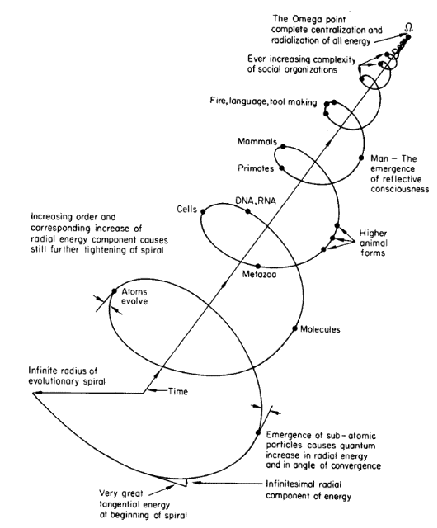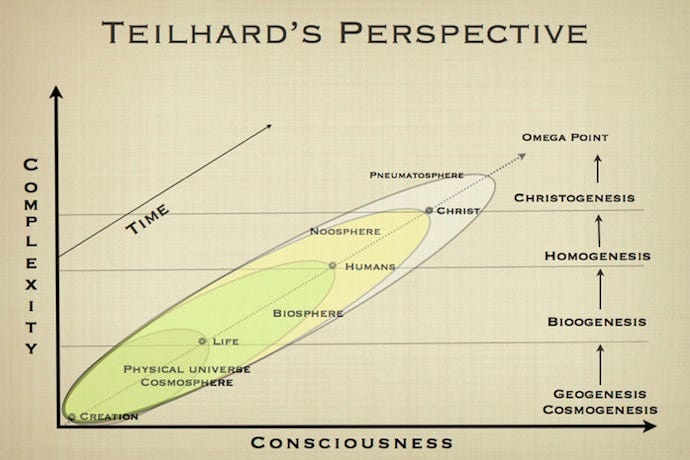I wish to present Brendan Graham Dempsey's discourse on designing new civilizations of ecology, religion, science, and cultural behaviours, as aligned with my own these past many years. And though I have been steadily applying AN Whitehead's Process Philosophy to all human disciplines, I sense Brendan's Emergentism group is eclectically picking-and-choosing across a similar space which I have described in the past as the additive parts to the whole of process thought as an integral philosophy to all previous thoughts and constructs. Hence, I deem Process Philosophy as a broadly holistic construct in which all other constructs fit within such as process theology, process religion, process science, process evolution, process ecology, and so... including the area of emergentism. So, let's get to it and see where emergentism goes as an eclectic practice drawing across a variety of thought systems in reviving and resurrecting global, regional and local cultures for the 21st Century.
R.E. Slater
June 1, 2024
 |
| amazon link |
 |
| Alfred North Whitehead (left) and Teilhard de Chardin (right) |
Emergentism | Lineage:
4. Process Theology
Nov 14, 2022
Another intellectual lineage rich in Emergentist insight is so-called “process theology,” a theological paradigm that parts with traditional notions of God as “eternal” and “unchanging” and instead stresses the ways in which God might be conceived as affected by temporal processes and subject to transformation. According to the process theologian John Cobb, “process theology may refer to all forms of theology that emphasize event, occurrence, or becoming over substance.”
The origins of process theology lie in the philosophy of Alfred North Whitehead, an influential English mathematician and philosopher active in the early 20th century. Drawing on a biological metaphor, Whitehead referred to his approach as the “philosophy of organism,” and saw reality itself as a dynamic, processual unfolding of potentialities into actualities. In his magnum opus Process and Reality, he articulates his conception of God according to this “philosophy of organism” in a manner highly consistent with the Emergentist vision.
According to Whitehead, God is “dipolar,” possessing both an original, primordial nature on one side and a complete, consequent nature on the other. In his primordial nature, God is “unconscious,” existing only as pure conceptual potential. Only through temporal existence does God gain actuality and consciousness:
One side of God’s nature is…primordial, eternal, actually deficient, and unconscious. The other side originates with physical experience derived from the temporal world, and then acquires integration with the primordial side. It is determined, incomplete, consequent, ‘everlasting,’ fully actual, and conscious.
God thus begins, according to Whitehead, as a purely conceptual idea—an abstract notion entirely “deficient” in terms of actuality and realness. He is transcendent and ideal, but not yet real. It requires converse with the immanent world of time and material for God to emerge in all actuality and full consciousness. “God is to be conceived as originated by conceptual experience with his process of completion motivated by consequent, physical experience, initially derived from the temporal world.”
In this way, the primordial God is only like a pale image or design of what actual experience will render vibrant and real—a bare, undetermined possibility that becomes clothed through the subjective reality of the consequent God. As Whitehead puts it, “The consequent nature of God is conscious…the weaving of God’s physical feelings upon his primordial concepts.”

This concretizing of God in reality unfolds according to a metaphysical process involving a few “ultimate categories,” which Whitehead calls the one, the many, and creativity. As he puts it, “It lies in the nature of things that the many enter into complex unity.” That is, “The ultimate metaphysical principle is the advance from disjunction to conjunction”—a movement from multiplicity to complex, integrated unity—and this advance occurs through creative novelty. Through a fundamental push towards increasing newness, many parts combine to form greater wholes. “The many become one, and are increased by one.”
The product of this universal process is God, who develops towards his full realization guided by an internal “prehension” of reality, a generic sense of subjectivity that deepens towards full consciousness. Events succeed one another, their course being dictated by this deep prehensive “appetite,” “thirst,” or “urge,” whereby God gradually emerges into more integrated, novel unities.
According to Whitehead, each temporal moment comes together to form the full totality of experience, which is ultimately retained in the consequent God everlastingly. God is the sum of all experience, preserved forever. Whitehead writes:
The image—and it is but an image—the image under which this operative growth of God’s nature is best conceived, is that of a tender care that nothing be lost. …He saves the world as it passes into the immediacy of his own life. …The consequent nature of God is the fluent world become ‘everlasting’ by its objective immortality in God.
In this way, the continual change of evolution combines into a stable persistent unity. The creative advance of the many towards the one culminates in the realization of God. “Creation achieves the reconciliation of permanence and flux when it has reached its final term which is everlastingness—the Apotheosis of the World.”
Though, such a “final term” may not be so final, at least in terms of reaching some resting equilibrium. Reality is fundamentally dynamic and processual; creativity is truly essential to the nature of both God and world. In the “Apotheosis of the World,” then, “Neither God, nor the World, reaches static completion. Both are in the grip of the ultimate metaphysical ground, the creative advance into novelty. Either of them, God and the World, is the instrument of novelty for the other.” By means of this, the World becomes God, and God becomes World.
 |
| “Stardust Gazing Back” by Rob Rey |
The connections with Emergentism are clear and powerful. Whitehead provides a robust metaphysics for considering the complexification process as the “creative advance of novelty” motivated by an intrinsic divine urge towards Self-realization. In this Self-realization process, the Universe becomes apotheosed—rendered God—as it emerges to full consciousness from unconscious potentiality.
Another thinker often classed among the process theologians is the great Pierre Teilhard de Chardin, a French paleontologist, teacher, scientist, and Jesuit priest writing in the early to mid-20th century. As a theologian, de Chardin brought his extensive knowledge of geology, biology, anatomy, and evolutionary history to bear on reframing religion in processual terms. In amazingly prescient ways, he anticipated many of the insights of complexity science and consciousness studies that we have already encountered, tying these directly to a new conception of human spirituality.
De Chardin parted with the evolutionary scientists of his day who claimed to see no trajectory or direction to the evolutionary process. For de Chardin, the fossil record provided clear evidence, across species, that evolution clearly favored one thing at least: the emergence and development of nervous systems/brains. While it may be fashionable among scientists, even today, to see only meandering change,
from the moment that the measure (or parameter) of the evolving phenomenon is sought in the elaboration of the nervous systems, not only do the countless genera and species fall naturally into place, but the entire network of their verticils, their layers, their branches, rises up like a quivering spray of foliage. Not only does the arrangement of animal forms according to their degree of cerebralisation correspond exactly to the classification of systematic biology, but it also confers on the tree of life a sharpness of feature, an impetus, which is incontestably the hall-mark of truth. Such coherence—and, let me add, such ease, inexhaustible fidelity and evocative power in this coherence—could not be the result of chance. Among the infinite modalities in which the complication of life is dispersed, the differentiation of nervous tissue stands out, as theory would lead us to expect, as a significant transformation. It provides a direction; and therefore it proves that evolution has a direction.
For de Chardin, however, this “cerebralization” process was but the outward manifestation of a far more important inner development: the evolution of consciousness. Structural complexity was the exterior correlate of what he called “the within of things,” the interior, subjective reality of experience. It was towards the deepening of this subjective interiority that the Universe ultimately aimed. This idea is the guiding premise of all de Chardin’s profound works.
His most influential book, The Phenomenon of Man, is divided into three parts, each correlating to the three great phases of this evolutionary saga: “Pre-Life,” “Life, and “Thought” (akin to what we have been calling Matter, Life/Mind, and Culture): “three events sketching in the past and determining for the future…a single and continuing trajectory, the curve of the phenomenon of man.”
Beginning with Pre-Life (Matter), de Chardin not only considers the essential role of energy in the Universe’s complexification, but, almost prophetically, looks past the false narrative of thermodynamic heat death and dissolution (then still the consensus view) to appreciate instead how energy’s complexifying power holds the key to the future of the Universe. He writes:
[E]nergy nowadays represents for science the most primitive form of universal stuff. Hence we find our minds instinctively tending to represent energy as a kind of homogenous, primordial flux in which all that has shape in the world is but a series of fleeting ‘vortices.’ From this point of view, the universe would find its stability and final unity at the end of its decomposition. It would be held together from below. Let us keep the discoveries and indisputable measurements of physics. But let us not become bound and fettered to the perspective of final equilibrium that they seem to suggest. A more complete study of the movements of the world will oblige us, little by little, to turn it upside down; in other words, to discover that if things hold and hold together, it is only by reason of complexity, from above.
De Chardin goes even further, however, suggesting that “all energy is psychic in nature,” such that we may consider it as simultaneously the physical tangential energy drawing everything together, as well as “a radial energy which draws it towards ever greater complexity and centricity—in other words forwards” (cf. the Complexity-Consciousness Continuum, pp. 128-129).
But de Chardin does not invoke complexity as some vague notion; he offers a precise definition—one that, despite predating the advent of complexity science proper, is remarkably in accord with contemporary thinking. He writes:
We will define the ‘complexity’ of a thing as the quality the thing possesses of being composed -a. of a larger number of elements, which areb. more tightly organized among themselves.
In short, complexification entails an increase in parts forming wholes with increasing connections among them. More than that, de Chardin explicitly acknowledges the role of emergence in this complexification process, writing:
By its very construction, it is true, every organism is always and inevitably reducible into its component parts. But it by no means follows that the sum of the parts is the same as the whole, or that, in the whole, some specifically new value may not emerge.
All of this leads de Chardin to formulate what he calls the “Law of Complexity,” which states that for every outer increase in structural complexity in an entity there is a directly correlated inner increase in the level of consciousness.
The more complex a being is, so our Scale of Complexity tells us, the more is it centered upon itself and therefore the more conscious does it become. In other words, the higher the degree of complexity in a living creature, the higher its consciousness; and vice versa. The two properties vary in parallel and simultaneously. If we depict them in diagrammatic form, they are equivalent and interchangeable.
These insights, tying complexity to deepening consciousness and deepening consciousness to the direction of evolution, led de Chardin to see a clear story in evolution—one that we have already represented by the Emergentist Great Spiral of Becoming. He writes:
Thus the rising scale conforms both to the ascending movement toward higher consciousness and to the unfolding of evolutionary time. Does not this suggest that, by using the degree of complexity as a guide, we may advance very much more surely than by following any other lead as we seek to penetrate to the truth of the world and to assess, in terms of absolute values, the relative importance, the place, of all things?
The absolute value that de Chardin posits as the culmination of this complexification process is the “Omega Point” (his coinage) of time. As a Christian thinker, de Chardin articulates this spiritual telos as a “Christogenesis,” the emergence of the truly incarnate divine in the world, the “awareness of the rise of a certain universal Presence which is at once immortalizing and unifying.” Far from a mere technological singularity, de Chardin envisions the Omega Point of mankind as a kind of mystical awakening to the ultimate divine fullness.



No comments:
Post a Comment